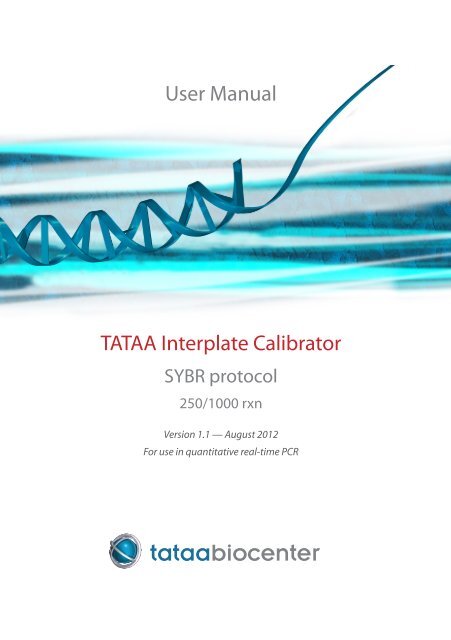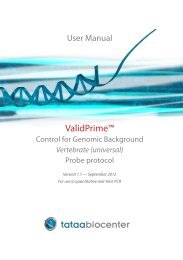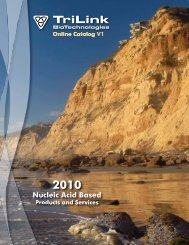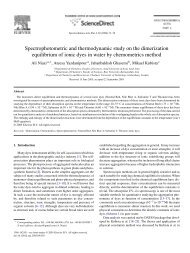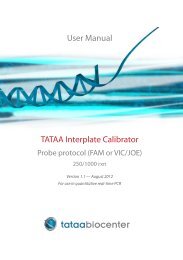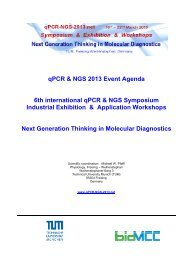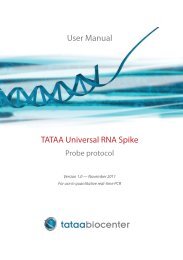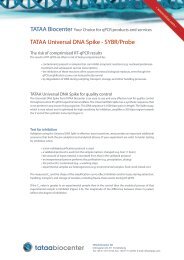TATAA Interplate Calibrator User Manual - TATAA Biocenter
TATAA Interplate Calibrator User Manual - TATAA Biocenter
TATAA Interplate Calibrator User Manual - TATAA Biocenter
Create successful ePaper yourself
Turn your PDF publications into a flip-book with our unique Google optimized e-Paper software.
<strong>User</strong> <strong>Manual</strong><br />
<strong>TATAA</strong> <strong>Interplate</strong> <strong>Calibrator</strong><br />
SYBR protocol<br />
250/1000 rxn<br />
Version 1.1 — August 2012<br />
For use in quantitative real-time PCR
<strong>TATAA</strong> <strong>Interplate</strong> <strong>Calibrator</strong> SYBR<br />
Table of contents<br />
Background 4-6<br />
Contents 6<br />
Additionally required materials<br />
and devices 6-7<br />
Storage 8<br />
<strong>Interplate</strong> calibration - additional information 8-9<br />
Protocol - <strong>Interplate</strong> calibration 10-11<br />
GenEx 11<br />
Troubleshooting 12<br />
References 13<br />
Reorder information 13<br />
Contact 13<br />
License information 13<br />
Other products from <strong>TATAA</strong> 14-15<br />
qPCR training courses at <strong>TATAA</strong> <strong>Biocenter</strong> 15<br />
3
Background<br />
For practical reasons many qPCR studies involve the use of samples that are<br />
processed in more than a single batch or in which the sample set is extended<br />
over time. Even over a short time period, variation between qPCR processing<br />
runs is observed due to different baseline subtractions and threshold settings.<br />
The bias is NOT introduced when using the “all samples” or “all assays” plate<br />
layout and performing ΔΔC q<br />
based analysis, but it is the “mixed” layout for<br />
which interplate calibration is needed (Figure 1). The <strong>TATAA</strong> <strong>Interplate</strong> <strong>Calibrator</strong><br />
(IPC) is used to compensate for the variation between qPCR runs. The <strong>TATAA</strong><br />
IPC sample material is provided in ready-to-use aliquots and is a very stable<br />
template that is amplified with a highly robust assay. The <strong>TATAA</strong> IPC should be<br />
included in all qPCR runs. Any differences in the measured IPC C q<br />
values among<br />
the runs reflect the bias introduced by the instrument and is compensated for.<br />
Figure 1: Different options for the design of a multi-plate qPCR study<br />
for ΔΔC q<br />
based analysis. Top left: the study contains 24 samples and 16<br />
genes and requires four runs with 96-well block instruments (y-axis:<br />
samples, x-axis: genes). Top right: “All samples” are always assayed on<br />
the same plate. Bottom left: “All genes” are always assayed on the same<br />
plate. Bottom right: “Mixed“ design which requires interplate calibration.<br />
The <strong>TATAA</strong> IPC is also suited for absolute quantification. The recommended<br />
strategy is to construct a single, highly precise standard curve for your target<br />
gene. Base it on large number of standards covering a wide concentration range<br />
4
<strong>TATAA</strong> <strong>Interplate</strong> <strong>Calibrator</strong> SYBR<br />
(recommended 7-9 concentrations, each run in 3-4 replicates). This standard<br />
curve is then used for interpolation of all field samples. The field samples may<br />
be measured over time in independent runs. Proper interpolation then requires<br />
that the IPC sample is included in each run. This approach is much more accurate<br />
than running a separate standard curve in each run, particularly if based on a<br />
smaller number of standards, since the random noise in the separate standard<br />
curves introduces systematic run-to-run variation (Tichopad 2012).<br />
The C q<br />
of the IPC is measured with high accuracy. The <strong>TATAA</strong> IPC has been<br />
extensively optimized to reliably and predictably amplify, providing highly<br />
reproducible C q<br />
values. However, it is still recommended as good practice to<br />
run technical replicates of the <strong>TATAA</strong> IPC (preferably at least triplicates, Figure<br />
2). Poor assays should never be used as interplate calibrators, since the noise<br />
contributed by these measurements may in turn worsen the quality of the data<br />
rather than improving it. It is sufficient to run one set of IPC replicates for each<br />
instrument channel used within a study if a common threshold is set. Hence,<br />
for most singleplex assay, technical replicates of a single IPC are sufficient. It is<br />
not recommended to perform separate inter plate calibrations for each assay,<br />
since the noise contributed by the independent corrections is likely to reduce<br />
data quality.<br />
SEM<br />
0.3<br />
0.2<br />
0.1<br />
IPC assay<br />
Rotorgene (72)<br />
Viia7 (384)<br />
LC480 (384 2nd derivative)<br />
LC480 (384 fit points)<br />
0.0<br />
15<br />
2<br />
5<br />
10<br />
20<br />
25<br />
number of qPCR replicates<br />
30<br />
Figure 2: The relationship between the standard error of the mean<br />
(SEM) and the number of replicates used in runs with identical settings<br />
except for their being processed on different instruments (see figure<br />
legend). LC480 shows two different threshold settings on one run.<br />
5
<strong>TATAA</strong> <strong>Interplate</strong> calibrator is:<br />
• provided in aliquots (stored at -20°C) for easy and flexible use and long term<br />
stability.<br />
• a robust assay that performs excellent in most master mixes and over a wide<br />
range of annealing temperatures.<br />
• a stable template at optimum concentration that produces C q<br />
≈ 10 -15 under<br />
most conditions.<br />
Contents<br />
• <strong>Interplate</strong> <strong>Calibrator</strong> (IPC) template:<br />
50 aliquots @ 20 μl (c = 10 6 copies / μl)<br />
or 200 aliquots @ 20 μl (c = 10 6 copies / μl)<br />
• IPC primers:<br />
5 aliquots @ 50 rxns* (250 μl of primer mix, c = 2 μM per primer)<br />
or 20 aliquots @ 50 rxns* (1000 μl of primer mix, c = 2 μM per primer)<br />
*rxns = qPCR reaction in 25 μl, concentration = 400nM per primer<br />
The IPC assay produces a 100 bp amplicon with very high PCR efficiency<br />
(E > 90% in tested commercial master mixes) and produces negligible primer<br />
dimer products.<br />
Additionally required materials and devices<br />
• Real-time PCR instrumentation<br />
The <strong>TATAA</strong> <strong>Interplate</strong> <strong>Calibrator</strong> has been validated on the Roche LightCycler<br />
480, Biorad CFX 96/384, Stratagene MxPro, Rotorgene, ABI 7500 Fast, Eppendorf<br />
Realplex, Illumina Eco, Fluidigm BioMark and is expected to perform well<br />
on equivalent instruments.<br />
• Master mix<br />
The <strong>TATAA</strong> <strong>Interplate</strong> <strong>Calibrator</strong> assay has been validated in a large number of<br />
master mixes using conditions recommended by the manufacturers (Table 1):<br />
6
<strong>TATAA</strong> <strong>Interplate</strong> <strong>Calibrator</strong> SYBR<br />
Master mix<br />
Final<br />
concentrations*<br />
Annealing<br />
temperature<br />
Applied Biosystems Fast SYBR® Green Master Mix 400 nM primer = 60°C (60-65)<br />
Biorad iQ SYBR® Green Supermix 400 nM primer = 60°C (57-65)<br />
Biorad SsoFast EvaGreen® Supermix 300 nM primer = 60°C (55-61)<br />
Finnzymes DyNAmo ColorFlash SYBR® Green qPCR Kit 400 nM primer = 60°C (59-65)<br />
Finnzymes DyNAmo Flash SYBR® Green qPCR Kit 400 nM primer = 60 °C (59-65)<br />
Invitrogen Express SYBR® Greener 200 nM primer = 60 °C (57-65)<br />
KAPA SYBR® FAST qPCR Kit 200 nM primer = 60 °C (57-63)<br />
Qiagen QuantiTect SYBR® Green PCR Kit 300 nM primer = 60 °C (57-61)<br />
Quanta PerfeCTa® SYBR® Green Fastmix 300 nM primer = 60 °C (55-62)<br />
Quanta PerfeCTa® SYBR® Green SuperMix 300 nM primer = 60 °C (55-62)<br />
Roche FastStart Universal SYBR® Green Master 300 nM primer = 60 °C (57-65)<br />
TAKARA SYBR® Premix Ex Taq II (Perfect Real time) 400 nM primer = 60 °C (59-65)<br />
TAKARA SYBR® Premix Ex Taq II (Tli RNaseH Plus) 400 nM primer = 60 °C (59-65)<br />
<strong>TATAA</strong> SYBR® GrandMaster® Mix 300 nM primer = 60 °C (56-62)<br />
Thermo Scientific ABSOLUTE QPCR SYBR® 400 nM primer = 60 °C (57-63)<br />
* Concentration of each primer per qPCR<br />
Table 1: Recommended primer concentrations and annealing temperatures<br />
in selected commercial master mixes. Acceptable ranges of annealing<br />
temperatures to synchronize <strong>TATAA</strong> <strong>Interplate</strong> calibrator assay with<br />
other experimental assays are shown within parenthesis. <strong>TATAA</strong> IPC assay<br />
performance has been validated within these temperature ranges.<br />
• Pipettes and tips (available from www.tataa.com)<br />
• Vortex and centrifuge<br />
• Experimental sample DNA/cDNA<br />
• Optionally reference cDNA and gDNA<br />
New assays can be validated on cDNA and DNA libraries available from <strong>TATAA</strong><br />
(www.tataa.com) for mouse, human or rat.<br />
7
Storage<br />
For long term storage store the <strong>TATAA</strong> <strong>Interplate</strong> <strong>Calibrator</strong> aliquots at -20°C.<br />
The <strong>TATAA</strong> IPC is stored in a stabilizing buffer and shows no degradation within<br />
a week at room temperature or after four freeze-thaw cycles (Figures 3, 4). The<br />
primer mix and probe may be stored at -20°C for up to a year or at +4°C for up<br />
to one month. Avoid repeated freeze-thaw cycles, use the provided aliquots<br />
instead.<br />
C q<br />
27<br />
26<br />
25<br />
24<br />
23<br />
Time stability of <strong>TATAA</strong> <strong>Interplate</strong> <strong>Calibrator</strong><br />
IPC in nuclease free H2O<br />
IPC in stabilizing buffer<br />
22<br />
0 1 2 3 4 5 6 7<br />
Time in room temperature (days)<br />
C q<br />
Freeze/thaw stability of <strong>TATAA</strong> <strong>Interplate</strong> <strong>Calibrator</strong><br />
27<br />
26<br />
25<br />
24<br />
23<br />
IPC in nuclease free H2O<br />
IPC in stabilizing buffer<br />
22<br />
0 1 2 3 4<br />
Freeze/thaw cycles<br />
Figure 3: Stability of <strong>TATAA</strong> <strong>Interplate</strong> calibrator<br />
template in time in room temperature.<br />
Figure 4: Stability of <strong>TATAA</strong> <strong>Interplate</strong> calibrator<br />
template after repeated cycles of<br />
freezing in -80 °C and thawing.<br />
<strong>Interplate</strong> calibration - additional information<br />
A basic requirement for a simple and efficient interplate calibration is having<br />
parallel amplification curves of all the assays in all the samples compared in the<br />
experiment (Figure 3). To achieve that, all assays should be validated, and any<br />
inhibited reaction should be excluded (MIQE guidelines, Bustin 2009). Given<br />
these requirements, any baseline subtraction and threshold setting method<br />
can be used with the IPC.<br />
If many different assays are used, amplification curves are rarely all parallel<br />
(Figure 6). The thresholds should be set at a level where the assay and the IPC<br />
response curves are parallel (Figure 5, 6).<br />
8
<strong>TATAA</strong> <strong>Interplate</strong> <strong>Calibrator</strong> SYBR<br />
Figure 5: Blue amplification curves are<br />
<strong>TATAA</strong> <strong>Interplate</strong> <strong>Calibrator</strong>. The curves<br />
are parallel in complete range.<br />
Figure 6: Blue amplification curves are<br />
<strong>TATAA</strong> <strong>Interplate</strong> <strong>Calibrator</strong>. The thresholds<br />
should be set at a level where the<br />
assay and the IPC response curves are<br />
parallel.<br />
Different threshold settings:<br />
• 2nd derivative threshold, common threshold (manual or automatic), best<br />
fit, SD of noise:<br />
<strong>TATAA</strong> <strong>Interplate</strong> <strong>Calibrator</strong> can be used if all the assays are well optimized and<br />
show similar amplification curves at least up to threshold.<br />
• Assay dependent threshold:<br />
If different thresholds are set for different assays (eg. because of very different<br />
probe fluorescence) a single <strong>TATAA</strong> <strong>Interplate</strong> <strong>Calibrator</strong> can still be used for all<br />
assays measured in the same instrument channel. For every threshold setting<br />
an IPC C q<br />
value is read and used for correction.<br />
• Inter-instrument calibration:<br />
If parts of a qPCR study must be measured on a different instrument (not<br />
recommended), but still using the same protocol, the <strong>TATAA</strong> <strong>Interplate</strong><br />
<strong>Calibrator</strong> can be used to remove most of the systematic variation.<br />
9
Protocol - <strong>Interplate</strong> calibration<br />
1. Design your experiment and plan where to include the <strong>TATAA</strong> <strong>Interplate</strong><br />
<strong>Calibrator</strong>. We recommend running minimum of three qPCR technical<br />
replicates of the <strong>TATAA</strong> IPC in every run.<br />
Recommendation: Putting the IPC in the same position on the plate in every run<br />
makes analysis more convenient (uniformity should not be a problem on a well<br />
calibrated qPCR instrument).<br />
2. Use in-house PCR reagents and recommended primer concentration for<br />
qPCR. Add 2 µl of <strong>TATAA</strong> <strong>Interplate</strong> <strong>Calibrator</strong> template (2*10 6 copies) in<br />
each qPCR replicate. Expected C q<br />
value is 10 –15.<br />
Recommendation: Prepare for a slightly larger number of reactions to avoid running<br />
out of master mix during pipetting. Add all components, vortex gently, spin<br />
down and dispense in replicates. The primer stock concentration is 2 μM, note the<br />
different concentration compared to other <strong>TATAA</strong> primer products. This to achieve<br />
more accurate liquid handling for such a low number of replicates. We advise adding<br />
2 μl of IPC per sample as pipetting of larger volumes is more accurate. It is not<br />
necessary to include a non-template control (NTC) for IPC.<br />
3. Perform qPCR with the protocol recommended for your reagents and as<br />
optimized for your assays. Often 60°C annealing temperature is used on<br />
three/two step SYBR protocols and qPCR conditions that have been validated<br />
for the <strong>TATAA</strong> <strong>Interplate</strong> <strong>Calibrator</strong> are shown in Table 1. The amplicon<br />
produced by the <strong>TATAA</strong> IPC assay is 100 bp long.<br />
4. Inspect data. The amplification curves of the <strong>TATAA</strong> <strong>Interplate</strong> <strong>Calibrator</strong><br />
(IPC) assay should be parallel with those of your assays at least up to<br />
threshold (if it is not, see section “additional information”). Collect the C q<br />
values for all the runs and average those of the IPC replicates in each run.<br />
The standard deviation (SD) of IPC replicates should be ≤ 0.3 cycles and<br />
usually it is substantially lower (the reproducibility is usually limited by the<br />
performance of your qPCR instrument). Data are corrected for the variation<br />
between runs using the equation:<br />
10
<strong>TATAA</strong> <strong>Interplate</strong> <strong>Calibrator</strong> SYBR<br />
Cq<br />
corrected<br />
uncorrected<br />
IPC<br />
i<br />
= Cq i<br />
- Cq +<br />
i<br />
_________<br />
1<br />
no. plates<br />
no. plates<br />
Cq<br />
∑<br />
i=1<br />
IPC<br />
i<br />
For each plate subtract the Cq from the measured Cq i<br />
and add the<br />
average of the C q<br />
’s off all IPCs ( 1<br />
no. plates<br />
_________<br />
IPC<br />
∑ Cq ).<br />
i<br />
no. plates<br />
IPC<br />
i<br />
i=1<br />
uncorrected<br />
For convenient analysis, interplate calibration is part of the qPCR data analysis<br />
workflow in softwares such as GenEx.<br />
GenEx<br />
To enable automatic analysis, runs and interplate calibrators should be indexed<br />
in classification columns. It is easy to do this manually, however if you use preplated<br />
reactions by leading vendors GenEx will automatically identify interplate<br />
calibrators and annotate your experiment accordingly. A free license for GenEx<br />
Enterprise is available for download from www.multid.se and provides the fully<br />
functional analysis software for a trial period of 30 days. To purchase GenEx<br />
licenses or for qPCR data analysis services, contact us at order@tataa.com.<br />
GenEx is market-leading software for qPCR experimental design and data<br />
processing, and is supported by all leading qPCR instrument manufacturers.<br />
It offers user-friendly optimized workflows for qPCR data pre-processing and<br />
analysis, including normalization using spikes and identification of inhibited<br />
outliers. Pre-processing includes interplate calibration, efficiency correction,<br />
various normalization options, handling of technical replicates and missing<br />
data, normalization with paired samples, and correction for gDNA contamination<br />
using ValidPrime. Analyses include absolute quantification, relative<br />
quantification, and expression profiling. Tutorials are available on: www.<br />
multid.se/tutorials.php and free support is offered on: www.qpcrforum.com.<br />
11
Troubleshooting<br />
• I do not get any amplification/signal?<br />
The instrument may not have been programmed correctly or there may be a<br />
problem with the master mix. Establish if the problem is in the detection or the<br />
amplification step by running the samples on a gel. Run a new test using the<br />
IPC template with the IPC assay provided. If the problem persists, contact us at<br />
info@tataa.com<br />
• My replicates are not tight?<br />
With <strong>TATAA</strong> <strong>Interplate</strong> <strong>Calibrator</strong> template and primers and good pipetting<br />
technique, high reproducibility is expected (SD ≤ 0.3 C q<br />
) in all master mixes.<br />
SD ≤ 0.5 cycles can still be accepted, but the number of replicates should be<br />
increased for accurate interplate calibration. If other assays show such a low reproducibility,<br />
it is possible that the qPCR instrument is not performing well and<br />
should be validated (test for uniformity of the thermal block). Low amounts of<br />
template can lead to higher variation. Also, low quality RNA/DNA can lead to<br />
differences between replicates. Check the accuracy and reproducibility of your<br />
pipettes.<br />
• My negative controls are amplified?<br />
Your reagents are probably contaminated.<br />
• My samples have same/higher C q<br />
-value than my NTC?<br />
You have used too little template or complete inhibition is present. Add more<br />
RNA/DNA and try again. Check if the quality of the RNA/DNA is not compromised<br />
due to improper storage before performing RT-qPCR. Check if the<br />
instrument is set optimally.<br />
12
<strong>TATAA</strong> <strong>Interplate</strong> <strong>Calibrator</strong> SYBR<br />
References<br />
Bustin SA, Benes V, Garson JA, Hellemans J, Huggett J, Kubista M, Mueller<br />
R, Nolan T, Pfaffl MW, Shipley GL, Vandesompele J, Wittwer CT. The MIQE<br />
guidelines: minimum information for publication of quantitative real-time PCR<br />
experiments. Clin Chem. 2009 Apr;55(4):611-22.<br />
Kubista M, Rusnakova V, Svec D, Sjögreen B, Tichopad A. GenEx - Data Analysis<br />
Software. In qPCR in Applied Microbiology. Editor: Martin Filion. Horizon Press,<br />
2012.<br />
Tichopad A, Svec D, Pfaffl M, Kubista M. How good is a PCR efficiency estimate:<br />
Proposal of recommendations for precise and robust qPCR efficiency<br />
estimation. NucleicAcidResearch 2012<br />
GenEx user guide: http://www.tataa.com/files/pdf/GenEx<strong>User</strong>Guide.pdf<br />
Reorder information<br />
The <strong>TATAA</strong> <strong>Interplate</strong> <strong>Calibrator</strong> can be ordered from the <strong>TATAA</strong> webshop on<br />
www.tataa.com, or by mail: order@tataa.com, or from the <strong>TATAA</strong> distributor in<br />
your country.<br />
Contact<br />
For more information about <strong>TATAA</strong> <strong>Interplate</strong> <strong>Calibrator</strong> contact us at info@<br />
tataa.com<br />
License information<br />
PCR is covered by several patents owned by Hoffman-La Roche Inc., and Hoffman-LaRoche, Ltd.<br />
Purchase of this kit does not include or provide a license with respect to any PCR related<br />
patents owned by Hoffman-La Roche or others. <strong>TATAA</strong> <strong>Biocenter</strong> does not encourage or support the<br />
unauthorised or unlicensed use of the PCR process.<br />
13
Other products from <strong>TATAA</strong><br />
Universal RNA / DNA spike<br />
- for any species, tests for inhibition and yield<br />
The <strong>TATAA</strong> Universal Spike is an easy to use and very effective tool for quality<br />
control throughout entire RT-qPCR experimental workflow. Add the spike<br />
to the experimental sample and to a control based on water. Processing both<br />
samples exactly the same way – any inhibition in the experimental sample will<br />
impair the RT-qPCR resulting in higher C q<br />
than of the control sample. <strong>TATAA</strong><br />
Universal Spikes have a synthetic sequence that is not present in any known<br />
living organism. The Spike assay is exceedingly robust and is optimized for high<br />
sensitivity for inhibition. The C q<br />
of the Spike assay also reflects losses during<br />
extraction, handling, transport, and storage of samples, including freeze-thaw<br />
events during RT-qPCR.<br />
ValidPrime - mouse, human and other vertebrates<br />
ValidPrime is an assay to test for the presence of gDNA in test samples and<br />
when combined with a gDNA control sample, replaces all RT(-) controls. Valid-<br />
Prime is highly optimized and specific to a non-transcribed locus of gDNA<br />
that is present in exactly one copy per haploid normal genome. The kit also<br />
contains a gDNA standard that can be used to test the sensitivity of RT-qPCR<br />
assays for gDNA background. ValidPrime replaces the need to perform RT(-)<br />
controls for all reactions and makes RT-qPCR profiling easier and substantially<br />
cheaper.<br />
HL-dsDNase<br />
New generation DNase from Arcticzymes that is specific to double strand DNA<br />
and can be efficiently inactivated by heating at 55°C. It can be added to your RT<br />
reaction to efficiently remove any gDNA, without degrading single-stranded<br />
cDNA. It is completely inactivated by the PCR and does not degrade the double<br />
stranded PCR product.<br />
GenEx software<br />
Market leading software for qPCR analysis from MultiD Analyses. GenEx provides<br />
the appropriate tools to analyze qPCR gene expression data and to extract<br />
biologically relevant information from the measurements.<br />
14
<strong>TATAA</strong> <strong>Interplate</strong> <strong>Calibrator</strong> SYBR<br />
Reference Gene Panel - Human, Mouse, or Rat<br />
The panel contains primer sets for 12 commonly used human, mouse, or rat reference<br />
genes. A perfect product for finding the most optimal reference genes<br />
for your study. A one year license for GenEx Standard software with geNorm<br />
and Normfinder is included with the kit.<br />
VisiBlue qPCR mix colorant<br />
The VisiBlue mastermix colorant enables you to color your favourite qPCR master<br />
mix to easily visualize where the reagent is loaded to your plates and tubes.<br />
VisiBlue is very easy to use by simple addition to your favorite master mix.<br />
CelluLyser - for rapid and easy lysis and cDNA synthesis<br />
The CelluLyser Lysis and cDNA Synthesis Kit enables you to generate cDNA<br />
from small samples with minimal losses and hands-on time. It is particularly<br />
useful for single cell analysis. By using CelluLyser, the entire workflow from<br />
cell lysis to RT and qPCR can be performed without washing steps, thus eliminating<br />
material loss.<br />
<strong>TATAA</strong> GrandMaster® and GrandScript Series<br />
After specializing in qPCR for more than a decade, <strong>TATAA</strong> <strong>Biocenter</strong> now introduces<br />
its own series of mixes and cDNA synthesis kits for optimal and high quality<br />
results. Our mission is to deliver a reagent series that provides superior qPCR performances<br />
in a variety of applications and throughout the entire qPCR workflow.<br />
qPCR training courses at <strong>TATAA</strong> <strong>Biocenter</strong><br />
<strong>TATAA</strong> <strong>Biocenter</strong> is leading organizer of hands-on training in qPCR and related<br />
technologies. For comprehensive training program see www.tataa.com.<br />
15
Express your<br />
genius<br />
<strong>TATAA</strong> <strong>Biocenter</strong>, with offices in<br />
Gothenburg, San Francisco and<br />
Prague, is the leading provider of<br />
real-time PCR services and the prime<br />
organizer of real-time PCR workshops<br />
globally. <strong>TATAA</strong> <strong>Biocenter</strong> conducts<br />
commissioned research and<br />
training within the field of molecular<br />
diagnostics and gene expression<br />
analysis, along with developing realtime<br />
PCR expression panels. <strong>TATAA</strong><br />
<strong>Biocenter</strong> has great experience and<br />
expertise in high resolution gene<br />
expression profiling, pathogen detection,<br />
and small sample/single cell<br />
analysis.<br />
<strong>TATAA</strong> <strong>Biocenter</strong> AB<br />
Odinsgatan 28, 411 03 Göteborg<br />
Tel: +46 31 761 57 00, Fax: +46 31 15 28 90<br />
E-mail: info@tataa.com, Website: www.tataa.com


